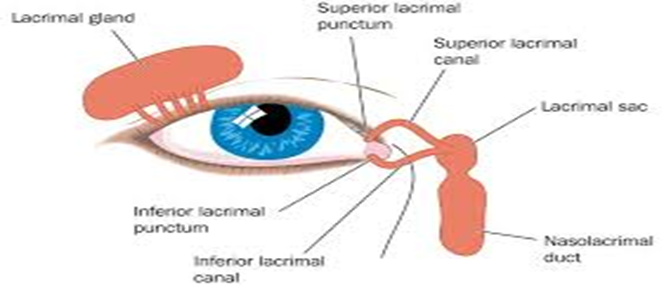A middle-aged school teacher complains of excessive tearing of the eyes every morning. Which assessment should the nurse perform next?
Assess the nasolacrimal sac
Inspect the palpebral conjunctiva
Test pupillary reaction to light
Perform the eye positions test
The Correct Answer is A
Choice A Reason:
The nasolacrimal sac is part of the tear drainage system. When a patient presents with excessive tearing, known as epiphora, it is important to assess for any obstruction in the lacrimal apparatus. The nasolacrimal sac can become blocked due to various reasons such as infection, inflammation, or structural abnormalities. Assessing this area can help determine if there is a blockage causing the tears to accumulate and overflow.
Choice B Reason:
Inspecting the palpebral conjunctiva is typically done if there is a complaint of eye pain or a sensation of a foreign body in the eye. While it is part of a comprehensive eye examination, it is not the first assessment to be performed for excessive tearing unless there are additional symptoms that suggest a problem with the conjunctiva.
Choice C Reason:
Testing the pupillary reaction to light is an assessment of the pupillary response and the function of the oculomotor nerve. This test is crucial when neurological issues are suspected or if there is a change in vision. However, it is not the primary assessment for excessive tearing without other associated symptoms.
Choice D Reason:
The eye positions test, which assesses eye muscle strength and cranial nerve function, is not necessary unless there are signs of problems with muscle strength, such as drooping. This test would not typically be the next step in assessing a patient with excessive tearing unless there are other indications of muscle or nerve impairment.

Nursing Test Bank
Naxlex Comprehensive Predictor Exams
Related Questions
Correct Answer is B
Explanation
Choice A Reason:
Tracheal sounds are harsh, high-pitched breath sounds typically heard over the trachea in the neck. They are not expected to be heard over the peripheral lung fields of a young adult during a routine lung auscultation.
Choice B Reason:
Vesicular breath sounds are the normal sounds heard over most of the lung fields. They are characterized by a soft, low-pitched, rustling sound during inhalation and are softer during exhalation. These sounds are created by air moving through the smaller airways such as the bronchioles and alveoli.
Choice C Reason:
Bronchovesicular sounds are heard over the major bronchi and are characterized by a moderate pitch and intensity. They are typically heard between the first and second intercostal spaces at the sternal border anteriorly and between the scapulae posteriorly, not over most of the lung fields.
Choice D Reason:
Bronchial breath sounds are high-pitched and louder than vesicular sounds, with a hollow quality, and are normally heard over the manubrium. If heard over the peripheral lung fields, they may indicate lung consolidation or other abnormalities.
Correct Answer is ["A","C","D"]
Explanation
Choice A Reason:
Assessing vital signs is crucial for evaluating the client's responses to treatment. Changes in vital signs can indicate whether the body is responding positively or negatively to a treatment, allowing healthcare providers to adjust care plans accordingly. For example, a decrease in fever after administering antipyretics would suggest the treatment is effective.
Choice B Reason:
While carrying out orders from the healthcare provider is a responsibility of the nurse, it is not the primary reason for assessing vital signs. Vital signs are assessed to inform clinical decisions, not solely to fulfill orders. Therefore, this choice is not correct in the context of the importance of vital sign assessment.
Choice C Reason:
Monitoring risks for alterations in health is another key reason for assessing vital signs. Vital signs can serve as early indicators of health issues, such as the onset of an infection indicated by a rising temperature or cardiovascular problems suggested by changes in blood pressure or heart rate.
Choice D Reason:
Establishing a baseline is essential when assessing vital signs. It provides a reference point for future comparisons, which is important for detecting any deviations from the client's normal range. This helps in identifying potential health issues early and monitoring the progression of known conditions.
Whether you are a student looking to ace your exams or a practicing nurse seeking to enhance your expertise , our nursing education contents will empower you with the confidence and competence to make a difference in the lives of patients and become a respected leader in the healthcare field.
Visit Naxlex, invest in your future and unlock endless possibilities with our unparalleled nursing education contents today
Report Wrong Answer on the Current Question
Do you disagree with the answer? If yes, what is your expected answer? Explain.
Kindly be descriptive with the issue you are facing.
